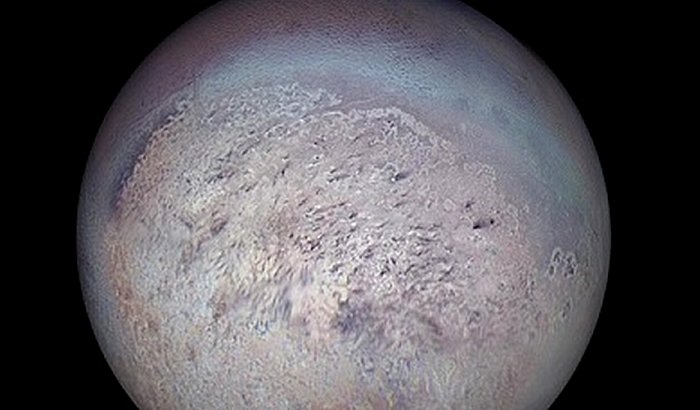Eddie Gonzales Jr. – MessageToEagle.com – Astronomers using the Gemini Observatory explore Neptune’s largest moon Triton and observe, for the first time beyond the lab,
An extraordinary union between carbon monoxide and nitrogen ices, has been observed for the first time by astronomers using the 8-meter Gemini South Telescope in Chile. Researchers have pinpointed a very specific wavelength of infrared light absorbed when carbon monoxide and nitrogen molecules join together and vibrate in unison.
Voyager 2 image of Triton showing the south polar region with dark streaks produced by geysers visible on the icy surface. Credit: NASA/JPL.
Individually, carbon monoxide and nitrogen ices each absorb their own distinct wavelengths of infrared light, but the tandem vibration of an ice mixture absorbs at an additional, distinct wavelength identified in this study.
Extreme conditions can produce extreme results. In this case, it’s the uncommon pairing of two common molecules – carbon monoxide (CO) and nitrogen (N2) – frozen as solid ices on Neptune’s frigid moon Triton.
The team also recorded this same unique infrared signature on Triton.
“While the icy spectral fingerprint we uncovered was entirely reasonable, especially as this combination of ices can be created in the lab, pinpointing this specific wavelength of infrared light on another world is unprecedented,”Stephen C. Tegler of Northern Arizona University’s Astrophysical Materials Laboratory who led the international study, said in a press release.
In the Earth’s atmosphere carbon monoxide and nitrogen molecules exist as gases, not ices. In fact, molecular nitrogen is the dominant gas in the air we breath, and carbon monoxide is a rare contaminant that can be lethal.
On distant Triton, however, carbon monoxide and nitrogen freeze as solid ices. They can form their own independent ices, or can condense together in the icy mix detected in the Gemini data. This icy mix could be involved in Triton’s iconic geysers first seen in 1989, in Voyager 2 spacecraft images as dark, windblown streaks on the surface of the distant, icy moon.
“Despite Triton’s distance from the Sun and the cold temperatures, the weak sunlight is enough to drive strong seasonal changes on Triton’s surface and atmosphere,” adds Henry Roe, Deputy Director of Gemini and a member of the research team.
Written by Eddie Gonzales Jr. – MessageToEagle.com Staff Writer







